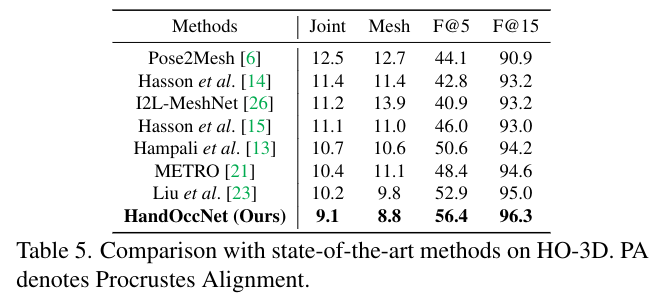This repository is the offical Pytorch implementation of HandOccNet: Occlusion-Robust 3D Hand Mesh Estimation Network (CVPR 2022). Below is the overall pipeline of HandOccNet.

The ${ROOT} is described as below.
${ROOT}
|-- data
|-- demo
|-- common
|-- main
|-- output
datacontains data loading codes and soft links to images and annotations directories.democontains demo codes.commoncontains kernel codes for HandOccNet.maincontains high-level codes for training or testing the network.outputcontains log, trained models, visualized outputs, and test result.
You need to follow directory structure of the data as below.
${ROOT}
|-- data
| |-- HO3D
| | |-- data
| | | |-- train
| | | | |-- ABF10
| | | | |-- ......
| | | |-- evaluation
| | | |-- annotations
| | | | |-- HO3D_train_data.json
| | | | |-- HO3D_evaluation_data.json
| |-- DEX_YCB
| | |-- data
| | | |-- 20200709-subject-01
| | | |-- ......
| | | |-- annotations
| | | | |--DEX_YCB_s0_train_data.json
| | | | |--DEX_YCB_s0_test_data.json
- Download HO3D(version 2) data and annotation files [data][annotation files]
- Download DexYCB data and annotation files [data][annotation files]
- For the MANO layer, I used manopth. The repo is already included in
common/utils/manopth. - Download
MANO_RIGHT.pklfrom here and place atcommon/utils/manopth/mano/models.
You need to follow the directory structure of the output folder as below.
${ROOT}
|-- output
| |-- log
| |-- model_dump
| |-- result
| |-- vis
- Creating
outputfolder as soft link form is recommended instead of folder form because it would take large storage capacity. logfolder contains training log file.model_dumpfolder contains saved checkpoints for each epoch.resultfolder contains final estimation files generated in the testing stage.visfolder contains visualized results.
- Install PyTorch and Python >= 3.7.4 and run
sh requirements.sh. - In the
main/config.py, you can change settings of the model including dataset to use and input size and so on.
In the main folder, set trainset in config.py (as 'HO3D' or 'DEX_YCB') and run
python train.py --gpu 0-3to train HandOccNet on the GPU 0,1,2,3. --gpu 0,1,2,3 can be used instead of --gpu 0-3.
Place trained model at the output/model_dump/.
In the main folder, set testset in config.py (as 'HO3D' or 'DEX_YCB') and run
python test.py --gpu 0-3 --test_epoch {test epoch} to test HandOccNet on the GPU 0,1,2,3 with {test epoch}th epoch trained model. --gpu 0,1,2,3 can be used instead of --gpu 0-3.
- For the HO3D dataset, pred{test epoch}.zip will be generated in
output/resultfolder. You can upload it to the codalab challenge and see the results. - Our trained model can be downloaded from here
Here I report the performance of the HandOccNet.
@InProceedings{Park_2022_CVPR_HandOccNet,
author = {Park, JoonKyu and Oh, Yeonguk and Moon, Gyeongsik and Choi, Hongsuk and Lee, Kyoung Mu},
title = {HandOccNet: Occlusion-Robust 3D Hand Mesh Estimation Network},
booktitle = {Conference on Computer Vision and Pattern Recognition (CVPR)},
year = {2022}
}
For this project, we relied on research codes from:

